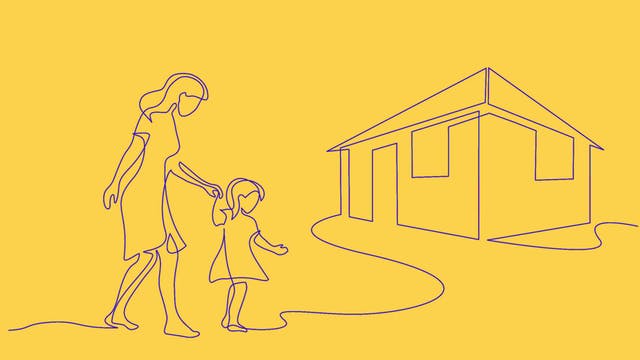Last fall, Gisela Sance’s landlord approached her family about raising the rent.
He wanted $2,000 a month, an astonishing hike over the $1,300 she and her husband were paying for the house they lived in with their young son. The decision to leave was painful but not hard: There was no way they could afford a 50 percent increase in their rent.
It was happening all around her — in Austin, Texas, where she lives, and elsewhere. But that knowledge provided little comfort when, in November, Sance found herself boxing up her family’s belongings.
“This move was an emergency,” she shares through a Spanish interpreter.
The new place they found was smaller, farther away from their community, and in Sance’s assessment, less safe — she has installed a security camera. When her family moved in, they found mold, cockroaches and a general state of disrepair. And at $1,650 a month, it was quite a bit more than they’d been paying at the last place but still the best rate they could find.
“I had to take it,” Sance explains. “I’m thankful that right now I am stable, but I do want to move [again].”
For any family, in any place, this situation would be disruptive. But for home-based child care providers like Sance, whose house doubles as an early care and education program by day, the situation is compounded.
During the move last fall, Sance lost all but one of the four children for whom she’d been providing care. At her last place, the families were practically neighbors, walking to her home each day to drop off their kids. Most were not in a position to follow her; only one had a car.
For home-based child care providers, the living situation is inseparable from the work, and when one suffers, the other does too. That tricky dynamic, while not new, has gotten more tenuous in recent years — particularly since the pandemic, with home prices skyrocketing, interest rates increasing and rental home prices inflating.
One quarter of child care providers surveyed between March 2021 and December 2022 reported difficulty affording housing expenses, regardless of whether they rent or own, according to RAPID, a project based out of Stanford University that gathers information about young children and their caregivers. Those rates were higher among Latino (36 percent) and Black (35 percent) providers, almost all of whom are women. Eviction and foreclosure are common concerns, too: 42 percent of providers worry about not being able to make their rent or mortgage payments.
It’s not just the cost of renting and buying homes that creates challenges either. In-home child care providers face a host of hurdles when it comes to housing, from resistance from landlords and homeowners associations (HOAs) to onerous licensing requirements and regulations.
Together, those barriers are forcing would-be or once-were caregivers out of the sector, which serves millions of children across the country. This is leaving a workforce that is overwhelmingly made up of women and is disproportionately people of color without livelihoods and reducing the already-scarce child care supply in the process.
Data collected over the past two decades by the Administration for Children and Families, a division of the U.S. Department of Health and Human Services, reveals the extent of the loss. Between 2005 and 2017, nearly half of all licensed home-based programs closed. By 2019, the number of licensed programs had further declined, with only about 91,000 remaining open across the United States, according to the National Survey of Early Care and Education.
While growth in center-based care capacity made up for those losses, it doesn’t help the millions of families who prefer a home-based setting. Some are attracted to the small-group aspect of it, the intimacy. Others choose it because it ties their child to a shared background or culture — perhaps a caregiver speaks the same language that the child’s family speaks at home or immigrated from the same country.
Home-based providers often describe their programs as feeling more like a second family than an institution, where providers go beyond the scope of the job description to attend birthday parties and sporting events or stay in touch with a family well after the youngest child starts school. There is trust and familiarity.
To get to that point, though, providers must be able to recruit willing families. The space itself matters a great deal in this equation, they say. A provider and their property is all a family sees when making a decision about where, and with whom, their child will spend the bulk of their time.
“Trying to find a property is like [looking for] a needle in a haystack,” explains Myra Saboor, a home-based provider in Atlanta, “because you’re trying to make sure you have adequate accommodation for your families — the kitchen, yard space, bathrooms, parking spaces, overall neighborhood. That’s what you’re marketing.”
Housing Hurdles
The Landlord Dilemma
Ja’Neka Lewis, a home-based child care provider in Henderson, Nevada, has been looking for a place since March, when the lease on her apartment ended.
She opted not to renew, wanting something bigger and more conducive to providing home-based child care. She was looking for a house with a backyard and enough common space that her own family could have an area separate from where the children learn and play.
Lewis had no idea what she was in for, or how many times she’d be rebuffed. All she needs is one property owner to say yes to her. But no one will.
“It’s been hard having owners agree to it, see the benefit of it and not see it as a liability,” Lewis says. “You’re selling your business to them in a way.”
While she tours properties and makes her case to homeowners, Lewis and her partner and child have been staying in a friend’s house. It’s not ideal, she concedes. Without a place of her own, she has lost the business of two of the three children in her care. (She cares for the third part-time in the child’s home now.) She’s been making up the lost income with babysitting shifts and money she’d saved up to start her own center-based program some day.
Pushback from landlords and homeowners associations are common challenges for home-based providers, says Natalie Renew, executive director of Home Grown, a national organization working to improve the quality of and access to home-based child care.
Landlords cite the additional wear and tear on their home that a group of young children would cause. They worry about lawsuits and liabilities if something were to go sideways. Homeowners associations add to the chorus — regardless of whether the provider owns the home or a landlord needs HOA approval — with concerns about disruptive noise in the neighborhood, increased traffic and limited parking spaces.
Renew and others interviewed for this story note that these concerns are largely unfounded and steeped in misconceptions about home-based child care.
For one, licensed child care providers are required to have liability insurance, Renew says, and because the state is going into their homes for regular and sometimes spontaneous inspections, providers keep their properties in tip-top condition.
Mia Pritts, vice president of strategic partnerships at Wonderschool, a child care marketplace, notes that objections on the grounds of noise or traffic come from “a lack of understanding about what a child care program in your community is. The opposition is misplaced.”
Landlords and members of HOAs have this image, Pritts says, of a 60-child operation with cars clogging up residential streets. But that’s not it at all. The average program serves only a handful of children, and the vast majority of sounds any neighbor would hear from that group, if they heard anything at all, would be “joyful noise … from a handful of children playing outside in the day,” Pritts says.
Many landlords and HOAs, Renew says, need to reframe what it would mean to have a child care program in their homes and communities. Especially in places where, on the very same block that a program could operate, families are searching desperately for a place to send their own children.
“If you bring your landlords and HOAs to the table and say to them, ‘How awesome would it be for us to put residents in your home, in your neighborhoods, that are going to fully occupy the facility at all times, have a promissory note from the state for payment, have been background checked within an inch of their lives, are insured top to bottom, and will be pillars of the community?’” Renew says. “Landlords should be saying, ‘Sign me up.’”
Hefty Price Tags, Low Wages
For many in-home caregivers, homeownership can feel like a pipe dream.
According to data collected from RAPID between July and December 2022, 83 percent of providers who rent their homes said they wanted to become homeowners. The biggest barriers, they said, were an inability to afford a down payment (66 percent) and a lack of affordable housing options (58 percent), followed by debt, low credit scores, inability to secure a loan and job insecurity.
These barriers all share a single explanation: Many home-based child care providers — like their counterparts in other child care settings — don’t earn a living wage.
Child care workers nationally earned a median annual wage of $24,230 in 2019, according to the most recent Early Childhood Workforce Index, published by the Center for the Study of Child Care Employment. Data from the same year, collected in the National Survey of Early Care and Education, shows that home-based providers were living in households with annual incomes between $39,000 and $65,000, on average.
Things have only worsened in the past three years. Thousands of home-based providers permanently closed their programs during the pandemic, unable to keep up with rising costs and shoulder periods of missed payments when children weren’t showing up. Many lack retirement savings or even emergency funds, nevermind the tens of thousands of dollars often needed for a down payment or the sound credit history for a mortgage loan.
Housing prices have soared since the pandemic began, with the national median sales price of houses in the United States growing by about 33 percent since early 2020. With interest rates up too, the market has more or less elbowed out providers who might’ve viewed the path toward homeownership as feasible.
As home prices have risen, so too have rental costs, adding to the obstacles in-home providers face. Landlords can list their houses for sale on a whim, forcing out their renters on short notice. In most states, child care providers have no recourse in those cases. They must find a new home and rebuild their program.
And unlike being a homeowner, renters can experience unpredictable and extreme changes to their monthly payments, like what happened to Sance, the Austin provider who had to move last fall. The median rent nationwide increased by nearly 18 percent in 2021 alone.

Sance’s situation further illustrates why renters might struggle to run child care businesses from their homes. She is now living in a two-bedroom house. She and her husband share their bedroom with their son, who is 6, so they can use the second bedroom and living room for her early childhood program. It’s too small to comfortably accommodate both her family and her program, but she’s been priced out of larger rentals.
Saboor, the provider in Atlanta, recently experienced a 30 percent rent increase on her home — a cost she’s only been able to incur, she says, because of American Rescue Plan funds that will eventually expire.
“We’re hearing from providers who rent of rent escalations that are through the roof,” Renew says.
Labyrinthine Rules and Regulation
Home-based child care is a business — more so, in many cases, than providers give themselves credit for. But because it deals with the care and safety of young children, it doesn’t get the same regulatory treatment as someone running, say, an Etsy shop out of their home.
"No one thinks children should be in unsafe environments," Pritts explains. "Health and safety regulations are really important."
Yet some of the measures in place to ensure the health, safety and well-being of children are doing more harm than good, according to numerous people interviewed for this story.
Examples of well-intentioned but burdensome requirements and regulations abound. Renew ticked off a few she’s heard: hard-wired sprinkler systems, three-section sinks, numerous basement exit points. Some of these requirements are quite costly, Renew notes, but add no fair market value to providers’ homes and may actually reduce it over time.
During a focus group-style conversation facilitated by Home Grown in January, Stacey Carpenter, a home-based provider in Weld County, Colorado, shared some of the challenges she’s faced over nearly two decades working in the field.
“Zoning has been an issue for us here, building codes, fire sprinklers — things that we can’t afford,” Carpenter said. “To retrofit this house for fire sprinklers? It would put me out of business. I don’t make enough money to do that here.”
For years, Carpenter operated her program below its care capacity due to zoning requirements that she couldn’t afford to address. She was licensed to serve nine children but only cared for six, meaning Carpenter missed out on additional income that she estimates cost her roughly $100,000 over a decade. In 2021, Carpenter began operating at full capacity after Colorado passed a law requiring that home-based child care programs be classified as residences for purposes of licensing and local regulations — the state’s effort to mitigate some of the barriers to entering and remaining in the field.
Saboor, in Atlanta, started her home-based program in 2008. At the time, she recalls, she successfully procured a state license to run the program but wasn’t aware that she also had to get a business license from the city. Saboor was slapped with a fine. Then she had to pay out-of-pocket for a building inspector who, among other additions, instructed her to buy and hang an “exit” sign over her back door. At the time, Saboor was caring only for infants. During her business hours, the only person present who could even read the newly installed exit sign was her.
Part of the challenge is navigating the inconsistencies at different levels. The state might have one set of criteria, while the city and county might have other, additional requirements. In effect, this amounts to a daunting sequence of hoops that providers are unable or unwilling to jump through.
In Nevada, a state requirement regarding outdoor play space has been interpreted to mean that only single family homes are eligible for licensed child care — not apartments or condos, and in many cases not townhomes or duplexes either. This requirement, no doubt intended to create better learning environments for children, has hampered countless caregivers from getting licensed and other individuals from pursuing a career as a child care provider at all.
These labyrinthine local and state regulations are only adding to the litany of challenges that stand in the way of home-based providers finding safe, stable housing for themselves and the children in their care. And the irony of it is that, in an attempt to make home-based child care safer and better for kids, all of the rules and requirements have only made home-based learning environments look and feel more like centers, when that may be a setting that parents and families had explored and ruled out.
Many in the field, including Renew and Pritts, talk about homeownership as a primary wealth-building tool in the United States and the surest path to stability for those who make up the early care and education workforce. Yet for many current or aspiring providers, the concept of buying and owning a home on paltry wages is so far-fetched as to be absurd.
The current processes in the early care and education system, Renew says, “are building on existing inequities in our society.” She mentions the racial wealth gap, gender-based bias and discrimination, and the inaccessibility of homeownership to immigrants and people from low-income backgrounds with bad credit.
The takeaway of all this, Renew says? “You’re discouraged from pursuing home-based child care.”
She adds: “We’re really worried about what we’re seeing.”


